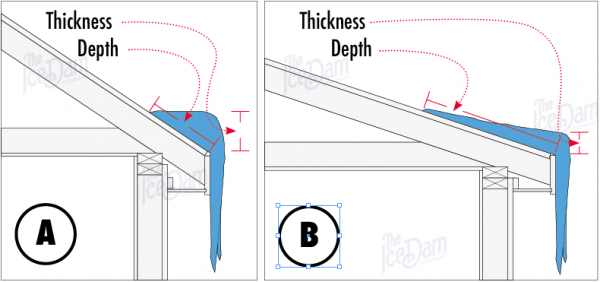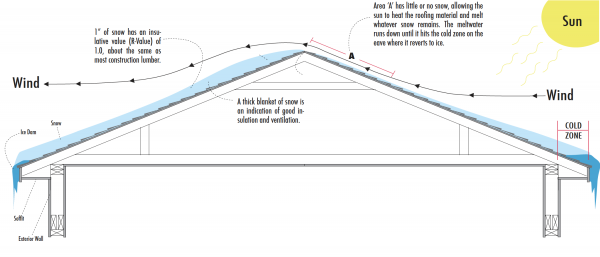Posts Tagged ‘minneapolis ie dam removal’
Thursday, December 1st, 2016
How Much Should it Cost to Have an Ice Dam Removed: Ice Dam Steaming Costs Explained by The Ice Dam Company
Ice Dam Removal: Pricing Vs. Cost
As mentioned in Case Study #05, there is a big difference between price and cost when trying to figure out how much your ice dam removal project will cost. The price is what someone tells you over the phone, normally relating to what they charge per hour for their ice dam removal services. We made a list of the 8 most common factors in determining the cost of ice dam removal in Case Study #05. Here is an examination of one major driver in ice dam removal cost: The depth of the ice dam.

Which takes longer to remove?
Intuition might suggest that thicker ice dams (A) take longer to remove then thinner ice dams (B). Not true. The main factor in the ice dam removal cost is how far up the roof the ice has grown. We refer to this as the ‘depth’ of the ice dam. Deeper ice dams take much longer to remove than those that are thick but shallow.
Estimating the Cost of Ice Dam Removal by Steam
You might think that after having removed thousands of ice dams around the country over the past 25 years we would be able to provide an accurate estimate over the phone as to how long a project might take. Sadly, we can’t. Anyone offering a guaranteed timeframe for ice dam removal projects over the phone is frankly full of it. We know that we can often remove between 10-15 feet of ice dam as measured along an eave every hour after the equipment is set up (C), below left. We know that there are many factors that determine the ultimate length of the ice dam steaming time, as discussed in Case Study #05. One of the main project timeframe drivers is ice dam depth and it can not be known until an experienced eye sees it and that can’t be known until the snow has been removed from the area. Until the ice dam is fully exposed it is impossible to know how long it will take to remove it. In the photos below, the ice dam on the right took three times longer to steam off than the ice dam on the left, even though it was 1/3 the thickness and the roof was a ‘walker’. It’s all about how far up the roof the ice has grown.


To read more Case Studies click here.
Tags: about ice dams, best ice dam removal in minneapolis, best rated ice dam removal contractor, edina ice dam removal, highest rated ice dam removal company in minneapolis, ice and snow removal, ice dam expert, ice dam heat cable, ice dam prevention, Ice dam removal, minneapolis ie dam removal, twin cities ice dam remover
Posted in Ice Dam Prevention, Ice Dam Removal, Ice Dams, Misc., Ice Dams: General Info | Comments Off on Ice Dam Removal Cost
Saturday, October 15th, 2016
How the Distribution of Snow Can Affect the Formation of Ice Dams
Snow and Ice Dams
There is a complex relationship between snow and ice dams. Yes, you need snow to get ice dams. Snow is, after all, the fuel that feeds the formation and growth of ice dams. Furthermore, it is unlikely to get ice dams unless there is an ongoing layer of snow on your roof over a period of time (normally at least 7-10 days). But it takes more than just having snow on your roof to get ice dams. See Ice Dam Company Case Study #23 for a list of contributing factors. One factor that seldom gets discussed is the affect of wind on the formation and severity of ice dams. While this is not a primary factor, it is something worth exploring. This Ice Dam Case Study looks at the affect a thinning snow cover has when seen on a roof slope that also faces the sun. The affect described below is exacerbated by the presence of darker roofing materials as they absorb more solar energy than lighter materials.
Mountains and Roofs Share Something in Common
Any skiers out there? Wind speeds increase near the ridge of a roof just like the top of a mountain. Snow on one side of the ridge is often swept away while remaining in place just on the other side of the peak. This phenomenon can affect both sides of a roof if wind direction changes from day to day, leaving the snow coverage thin or non-existent on the upper few feet of the roof below the ridge.

Condensation, The Silent Killer
The lack of an insulating snow blanket can allow heat from the inside of the home to meet cold exterior air in a thinner ‘conduction plane’. When heat hits a thin surface such as a roof decking, where there is a great temperature differential from one side to the other, condensation is also likely. Think of frost on old, single paned windows. The more space there is between the heat and cold, the more room there is for this interaction, greatly reducing the likelihood of condensation. A thick blanket of snow is a perfect insulator for this purpose. It creates more separation between the warmth being lost from the home and the frigid exterior air. Homes with thick snow coverage on their roofs generally seen as more efficient because heat is not escaping through the roofline to reduce the snow through melting.
To read more Case Studies click here.
Tags: about ice dams, best ice dam removal in minneapolis, best rated ice dam removal contractor, highest rated ice dam removal company in minneapolis, how do I know I have ice dams, how to tell if an ice dam is a problem, ice and snow removal, ice dam expert, ice dam removal jerks, ice removal company, minneapolis ie dam removal, steamer
Posted in Ice Dams, Misc., Ice Dams: General Info | Comments Off on Snow Distribution and Ice Dams
Tuesday, February 19th, 2013
Another ice dam removal method-round-up by Reuben, this time in the Star Tribune:
Hack Method of Ice Dam Removal Discussed
At the end of the article Reuben give Ice Dam Company a little screen time where Steve talks about the differences between a true ice dam steamer and high-temperature pressure washers.
Tags: Ice dam removal, ice dam removal jerks, minneapolis ie dam removal, steamer, twin cities ice dam remover
Posted in Ice Dam Removal | Comments Off on Reuben in the Strib









